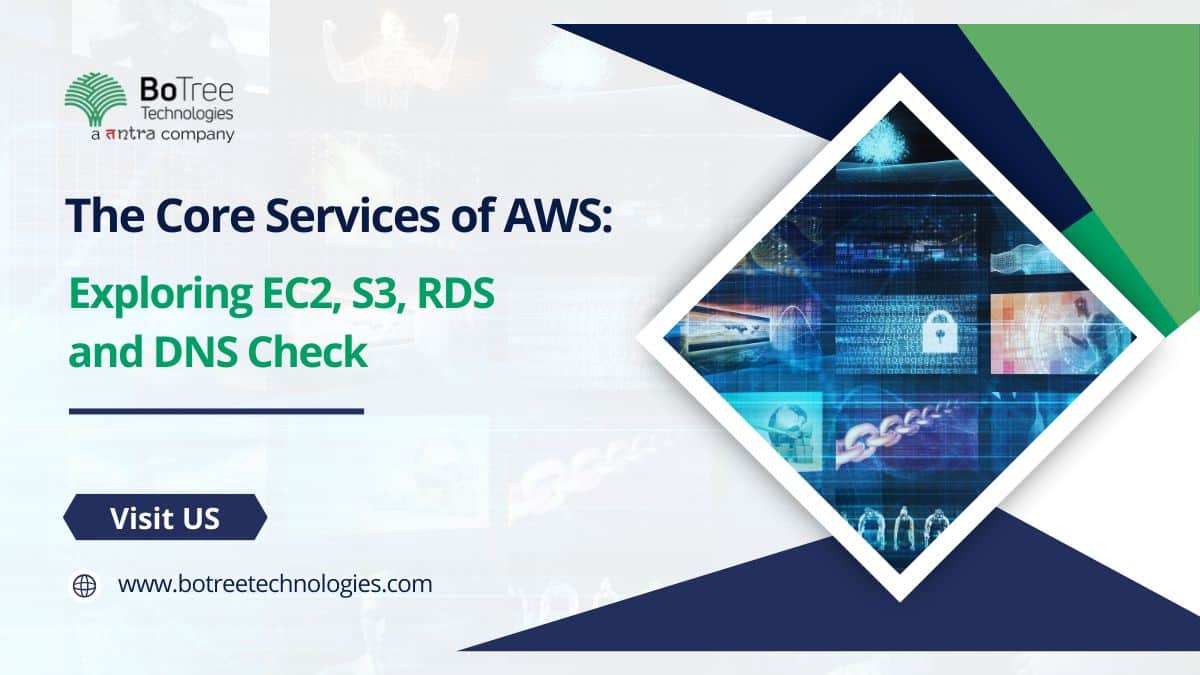
The Core Services of AWS: Exploring EC2, S3, RDS and DNS Check
Are you eager to learn about Amazon Web Services (AWS) foundational services? In this thorough guide, we’ll go in-depth on four essential AWS services: Amazon Elastic Compute Cloud (EC2), Amazon Simple Storage Service (S3), Amazon Relational Database Service (RDS), and DNS Check. These four services are crucial in the world of cloud-based applications. Understanding these AWS services is vital for architecting scalable and reliable applications within the AWS ecosystem, regardless of your level of expertise in cloud computing.
Amazon EC2: Empowering Virtual Servers in the Cloud
- Unveiling Amazon EC2
- The powerful web service, Amazon Elastic Compute Cloud (EC2), offers scalable computing capacity in the cloud. It enables you to design and manage virtual servers, also known as instances, that perfectly suit your requirements.
- The powerful web service, Amazon Elastic Compute Cloud (EC2), offers scalable computing capacity in the cloud. It enables you to design and manage virtual servers, also known as instances, that perfectly suit your requirements.
- Advantages of Utilizing EC2
- Because of its unmatched adaptability and scalability, EC2 is so alluring. With the flexibility to launch, customize, and scale instances in response to changing demand, EC2 is an excellent option for various applications, from hosting websites to running complex software solutions.
- Because of its unmatched adaptability and scalability, EC2 is so alluring. With the flexibility to launch, customize, and scale instances in response to changing demand, EC2 is an excellent option for various applications, from hosting websites to running complex software solutions.
- Navigating EC2 Instance Types
- For various workloads, EC2 offers a wide variety of instance types that have been painstakingly optimized. You have the option to match performance with your needs by selecting instances that are compute-, memory-, or GPU-powered.
- For various workloads, EC2 offers a wide variety of instance types that have been painstakingly optimized. You have the option to match performance with your needs by selecting instances that are compute-, memory-, or GPU-powered.
- EC2 Pricing Structures
- The On-Demand Instances, Reserved Instances, and Spot Instances pricing models for EC2 are flexible. Each model offers unique advantages that allow you to strike a balance between price and accessibility that meets the needs of your application.
- The On-Demand Instances, Reserved Instances, and Spot Instances pricing models for EC2 are flexible. Each model offers unique advantages that allow you to strike a balance between price and accessibility that meets the needs of your application.
- Getting Started with EC2
- Entering the world of EC2 is a simple process. Create an instance using your preferred Amazon Machine Image (AMI), set up security groups, and create an SSH connection after logging into the AWS Management Console. You have access to plenty of documentation that will walk you through each step of this process.
Amazon S3: A Haven for Cloud Storage
- Demystifying Amazon S3
- A highly scalable object storage service designed to store and access large data repositories, Amazon Simple Storage Service (S3) stands out. S3 is a top choice for data backup and storage due to its reputation for best-in-class resilience and availability.
- A highly scalable object storage service designed to store and access large data repositories, Amazon Simple Storage Service (S3) stands out. S3 is a top choice for data backup and storage due to its reputation for best-in-class resilience and availability.
- Features Enriching Amazon S3
- The appeal of S3 broadens to include a range of features, including cross-region replication, lifecycle policies, and data versioning. These capabilities allow you to exert exacting control over your data management efforts. Additionally, S3 offers a variety of storage classes, each with unique performance characteristics and associated pricing schemes.
- The appeal of S3 broadens to include a range of features, including cross-region replication, lifecycle policies, and data versioning. These capabilities allow you to exert exacting control over your data management efforts. Additionally, S3 offers a variety of storage classes, each with unique performance characteristics and associated pricing schemes.
- Unraveling S3 Data Consistency Models
- It’s essential to understand the data consistency models used by S3. All objects typically have strong read-after-write consistency, while overwriting PUTS and DELETES follow an eventual consistency model. This understanding is the foundation for creating applications that depend on precise and current data.
- It’s essential to understand the data consistency models used by S3. All objects typically have strong read-after-write consistency, while overwriting PUTS and DELETES follow an eventual consistency model. This understanding is the foundation for creating applications that depend on precise and current data.
- Safeguarding Data in S3 with Security Measures
- It is crucial to improve the security standing of your S3 data. This is accomplished by strategically implementing encryption mechanisms like SSE-S3, SSE-C, and SSE-KMS, along with the prudent application of bucket policies and access control lists (ACLs).
- It is crucial to improve the security standing of your S3 data. This is accomplished by strategically implementing encryption mechanisms like SSE-S3, SSE-C, and SSE-KMS, along with the prudent application of bucket policies and access control lists (ACLs).
- Mastering Data Upload and Management in S3
- Through the AWS Management Console or APIs, it is possible to upload data to S3 without difficulty. The division of data into buckets and folders streamlines your data organization processes. Tools like the AWS Command Line Interface (CLI) may help speed up data management even more.
Amazon RDS: Simplifying Relational Databases
- A Primer on Amazon RDS
- Amazon Relational Database Service (RDS) plays the diligent database management facilitator. It handles rote tasks like scaling, backups, and patching, freeing you to focus on more strategic initiatives. Numerous database engines, such as MySQL, PostgreSQL, Oracle, and Microsoft SQL Server, are supported by RDS.
- Amazon Relational Database Service (RDS) plays the diligent database management facilitator. It handles rote tasks like scaling, backups, and patching, freeing you to focus on more strategic initiatives. Numerous database engines, such as MySQL, PostgreSQL, Oracle, and Microsoft SQL Server, are supported by RDS.
- Diverse Database Engines Supported by RDS
- The variety of database engines that RDS supports demonstrates how broad it is. Your engine choice will depend on features, licensing requirements, and performance considerations.
- The variety of database engines that RDS supports demonstrates how broad it is. Your engine choice will depend on features, licensing requirements, and performance considerations.
- Boons of Incorporating RDS into Your Stack
- Choosing to incorporate RDS into your application framework has significant advantages. RDS improves your database management experience by introducing automated backups, high availability mechanisms, and seamless scalability. RDS also adds features enhancing performance and resilience, like Read Replicas and Multi-AZ deployments.
- Choosing to incorporate RDS into your application framework has significant advantages. RDS improves your database management experience by introducing automated backups, high availability mechanisms, and seamless scalability. RDS also adds features enhancing performance and resilience, like Read Replicas and Multi-AZ deployments.
- Managing and Creating RDS Instances
- The first step in starting an RDS instance is choosing an appropriate database engine, instance class, and storage configuration. An RDS instance can be expertly managed using the AWS Management Console or APIs once operational, making the task simple.
- The first step in starting an RDS instance is choosing an appropriate database engine, instance class, and storage configuration. An RDS instance can be expertly managed using the AWS Management Console or APIs once operational, making the task simple.
- Scaling and Backing Up RDS for Optimal Performance
- RDS can be scaled in two different ways: vertically by upgrading instance types and horizontally by deploying Read Replicas. Automated backups support data durability, and the availability of DB snapshots makes point-in-time recovery operations possible.
DNS Check: Ensuring Seamless Network Functionality
- The Significance of DNS Check
- The importance of DNS Check in preserving network health becomes clear. Domain Name System (DNS) configurations must be carefully examined and verified during this process to ensure dependable and seamless network functionality.
- The importance of DNS Check in preserving network health becomes clear. Domain Name System (DNS) configurations must be carefully examined and verified during this process to ensure dependable and seamless network functionality.
- Incorporating DNS Check into Your Architecture
- DNS Check can seamlessly integrate into your application architecture to improve network dependability and guard against potential disruptions. Regular DNS Check procedures aid in the early detection and correction of problems, ensuring the optimal performance of your cloud-based applications.
Building High Availability and Fault Tolerance
- Balancing Load Across EC2 Instances
- The key to achieving high availability and fault tolerance is using load balancers to distribute incoming traffic among numerous EC2 instances evenly. With this configuration, application performance is increased, and downtime is reduced.
- The key to achieving high availability and fault tolerance is using load balancers to distribute incoming traffic among numerous EC2 instances evenly. With this configuration, application performance is increased, and downtime is reduced.
- Enhancing Data Replication in S3
- Data is duplicated across various AWS regions due to utilizing cross-region replication in S3. This method strengthens data accessibility and durability, acting as a reliable backup plan in case of disaster.
- Data is duplicated across various AWS regions due to utilizing cross-region replication in S3. This method strengthens data accessibility and durability, acting as a reliable backup plan in case of disaster.
- Multi-AZ Configurations with RDS for Redundancy
- By implementing Multi-AZ deployments within RDS, standby replicas are created in different Availability Zones, enhancing redundancy. Automated failover mechanisms are implemented to increase availability and reliability.
Upholding Security Best Practices in AWS
- Fortifying Networks with EC2 Security Groups
- EC2 Security Groups control incoming and outgoing traffic to instances, acting as virtual firewalls. It is possible to protect examples from unauthorized access attempts by following security best practices.
- EC2 Security Groups control incoming and outgoing traffic to instances, acting as virtual firewalls. It is possible to protect examples from unauthorized access attempts by following security best practices.
- Elevating Data Security through S3 Encryption
- S3’s security posture is strengthened by its various encryption options, protecting data in transit and at rest. Sensitive information repositories are further protected by implementing encryption protocols.
- S3’s security posture is strengthened by its various encryption options, protecting data in transit and at rest. Sensitive information repositories are further protected by implementing encryption protocols.
- Ensuring RDS Security with Advanced Measures
- The Virtual Private Cloud (VPC) peering, SSL/TLS encryption, and robust database authentication mechanisms are just a few of the security features introduced by RDS. These steps help maintain the integrity and confidentiality of your data assets.
Monitoring and Efficient Management
- Proactively Monitoring EC2 Performance
- The AWS CloudWatch platform provides a way to monitor important EC2 instance performance metrics proactively. You can optimize resource usage and improve application responsiveness by configuring alarms to activate upon threshold breaches.
- The AWS CloudWatch platform provides a way to monitor important EC2 instance performance metrics proactively. You can optimize resource usage and improve application responsiveness by configuring alarms to activate upon threshold breaches.
- Gaining Insight into S3 Metrics and Monitoring
- Investigating S3 metrics reveals insightful information about request rates, data transfers, and storage usage. Utilizing these metrics makes it easier to analyze usage patterns, which ultimately helps you create a storage environment that is optimized.
- Investigating S3 metrics reveals insightful information about request rates, data transfers, and storage usage. Utilizing these metrics makes it easier to analyze usage patterns, which ultimately helps you create a storage environment that is optimized.
- RDS Performance Management Strategies
- Database performance metrics are clarified by RDS Performance Insights’ real-time monitoring and analysis capabilities. Your applications will be responsive if performance bottlenecks are found and fixed.
Strategies for Cost Optimization
- Innovative EC2 Cost Optimization Techniques
- Intelligent strategies for optimizing EC2-related costs while preserving performance levels include the strategic deployment of Reserved Instances, exact instance sizing, and the wise use of Spot Instances.
- Intelligent strategies for optimizing EC2-related costs while preserving performance levels include the strategic deployment of Reserved Instances, exact instance sizing, and the wise use of Spot Instances.
- Navigating the Realm of S3 Cost Management
- The key to mastering S3 cost management is to choose suitable storage classes, set up data lifecycle policies, and use tools like S3 Select to cut costs associated with data retrieval.
- The key to mastering S3 cost management is to choose suitable storage classes, set up data lifecycle policies, and use tools like S3 Select to cut costs associated with data retrieval.
- Enhancing RDS Cost Efficiency
- The most effective way to reduce RDS costs is to take a comprehensive approach that includes careful instance selection, wise use of Multi-AZ deployments for increased availability, and efficient automation of backup procedures.
- The most effective way to reduce RDS costs is to take a comprehensive approach that includes careful instance selection, wise use of Multi-AZ deployments for increased availability, and efficient automation of backup procedures.
Wrapping Up the Exploration
In this guide, we thoroughly studied Amazon Web Services’ core services, including Amazon EC2, S3, RDS, and DNS Check. Together, these services are the foundation upon which cloud-based applications are built. By exploring their features, benefits, and best practices, you can equip yourself with the necessary knowledge to maximize AWS’s capabilities and create reliable applications that suit your company’s needs perfectly.
Contact BoTree Technologies (a Tntra Company) today for Amazon Web Services.
FAQs
Q1: What is Amazon EC2 primarily used for?
A: Amazon EC2 is a versatile web service that creates and manages virtual servers within the cloud, providing scalable computing capacity for diverse applications.
Q2: How does Amazon S3 ensure data reliability?
A: Amazon S3 achieves exceptional data reliability through redundant storage mechanisms and automated error detection and correction procedures.
Q3: What is the standout benefit of using Amazon RDS?
A: Amazon RDS simplifies database management by automating routine tasks like backups, patching, and scaling, all while ensuring high availability and fault tolerance.
Q4: Can I integrate EC2, S3, RDS, and DNS Check into a unified application architecture?
A: Absolutely; integrating these services contributes to a well-architected and seamlessly functioning cloud application ecosystem.
Q5: How can I actively monitor the performance of my EC2 instances?
A: The AWS CloudWatch platform equips you with the tools to closely monitor EC2 instance performance metrics and establish alarms to notify you of threshold breaches.




